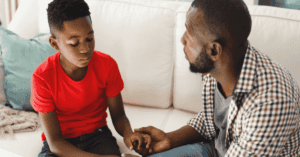Child-on-child abuse: Tips for parents and carers
We created this tips guide with insight from online safety expert Karl Hopwood and psychologist Dr Linda Papadopoulos to help parents and carers understand child-on-child abuse and how to deal with it if it happens.

What is child-on-child abuse?
Child-on-child abuse is when one child or young person causes harm to another. This can be at school, online or in other social situations. KCSIE (Keeping Children Safe in Education) lists these as some forms of child-on-child abuse, though it can be many things:
- Bullying (including cyberbullying, prejudice-based and discriminatory bullying)
- Abuse in intimate personal relationships between children
- Physical abuse
- Sexual violence and sexual harassment
- Consensual and non-consensual sharing of nude and semi-nude images
- Causing someone to engage in sexual activity without consent
- Upskirting (taking a photo under someone’s clothing without their permission)
- Initiation/hazing type violence and rituals.
Tips for parents and carers for how to deal with child-on-child abuse
Have age-appropriate conversations
Explain to them what inappropriate behaviour looks like as appropriate to their age and empower them to report anything that makes them uncomfortable, even if it’s done by a close friend. It’s important they don’t brush abusive behaviour off as harmless banter.
Set up privacy and security controls
With your child or teen, set up these controls. Explain how they work and what impact they could have on their safety. Setting them up together can help them develop their understanding and take ownership of their safety.
Teach digital resilience and responsibility
When they get their first device, help your child learn how to use the internet properly. This could include how to communicate with others and where to get help when they need it. Go along with them on their journey as they pass milestones like getting a new device or joining social media platforms to help them have positive interactions with others.